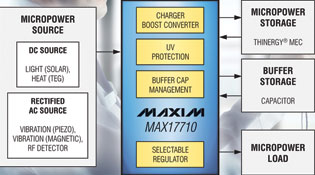Energy harvesting IC
17 August 2011
Power Electronics / Power Management

Maxim recently débuted the MAX17710, integrating all of the power management functions for ambient energy harvesting, as well as for charging and protecting micro-energy cells (MECs), a form of solid-state battery.
Operating at an ultra-low current level, the IC accepts energy from a variety of poorly regulated energy harvesting sources with output levels ranging from 1 μW to 100 mW. Examples include light (captured by photovoltaic cells), vibration (captured by a piezoelectric element), heat (captured by a thermoelectric generator) and RF (eg, near-field communications (NFC)).
The MAX17710 integrates a programmable input boost regulator and needs no expensive external components to charge a MEC with energy sources as low as 0,8 V. It protects the MEC by using a linear shunt series regulator. A low quiescent current, adjustable low-dropout linear regulator (LDO) with selectable voltages of 3,3 V, 2,3 V or 1,8 V allows the device to adapt to a variety of loads. Packaged in a low-profile 0,5 mm TQFN, the chip enables thin, card-like applications. It will also be available in wafer form to enable even thinner form factors.
At very low temperatures, all batteries exhibit increased characteristic impedance, which limits high pulse currents to the application loads. The MAX17710 integrates a feature that manages an external storage capacitor to augment the battery output and provide high pulse currents, even at very cold temperatures down to -40°C.
The device also works in power bridging applications where energy harvesting is not necessarily used. In such applications, infrastructure power (from the grid or a larger battery) is typically available to power the system and can trickle-charge an MEC for memory or RTC backup power. In the event of a loss of grid power or a system brownout during replacement of the larger system battery, the stored energy in the MEC continues to power volatile memory and/or an RTC for hours, days or even weeks. This solution displaces bulky coin cells and supercapacitors that have high self-discharge currents and limited life, especially at elevated temperatures.
The MAX17710 is targeted at powered smartcards, real-time clock (RTC)/memory backup applications and wireless sensor networks. Examples of wireless sensor networks include remote applications like irrigation valve control, building energy management, machine monitoring systems, asset tracking, biometric security systems, medical applications and a myriad of portable consumer electronics.
Further reading:
The importance of power integrity
Spectrum Concepts
Power Electronics / Power Management
[Sponsored] Behind every high-speed system lies the need for power integrity. Without it, even the cleanest signal paths become compromised.
Read more...
Precise multi-vital sign monitoring
Future Electronics
Power Electronics / Power Management
The AS7058 by ams OSRAM is an integrated multi-vital sign monitoring device, which provides a complete photoplethysmogram, electrocardiogram, body impedance sensor, and electrodermal activity sensor.
Read more...
Automotive battery diagnostics tester
Comtest
Power Electronics / Power Management
Midtronics’ MVT handheld battery tester is a revolutionary tool, powered by MDX-AI, which is set to redefine the standards of battery diagnostics and testing in the automotive industry.
Read more...
Advanced 3-phase controllers
Future Electronics
Power Electronics / Power Management
The STSPIN32G0 by STMicroelectronics is a family of highly integrated system-in-package providing solution suitable for driving three-phase brushless motors.
Read more...
Converting high voltages without a transformer
Altron Arrow
Editor's Choice Power Electronics / Power Management
With appropriate power converter ICs, such as the LTC7897 from Analog Devices, many applications can be suitably powered without having to use complex and cost-intensive transformers.
Read more...
Reliable power for demanding applications
Conical Technologies
Power Electronics / Power Management
The Mibbo Power MTR480 three-phase DIN-rail power supply is engineered to meet stringent industrial automation requirements, offering dependable performance in environments where downtime is not an option.
Read more...
Powering performance and precision
Future Electronics
Power Electronics / Power Management
onsemi’s innovative T10 series MOSFETs, available in 40 V and 80 V versions, are designed for high-efficiency, fast-switching, and power-dense applications.
Read more...
Programmable flyback switcher ICs
Future Electronics
Power Electronics / Power Management
Power Integrations has announced the release of the InnoSwitch5-Pro family of programmable flyback switcher ICs, which offer more than 95% efficiency in streamlined AC-DC converter designs.
Read more...
Multilayer chip beads with 8 A rating
RS South Africa
Power Electronics / Power Management
TDK Corporation has expanded its MPZ1608-PH series of large-current multilayer chip beads for automotive and commercial power supply lines.
Read more...
The role of bidirectional charging in the evolving energy landscape
Avnet Silica
Power Electronics / Power Management
As reliance on renewable sources like wind and solar continues to grow, the need for efficient energy flow and storage solutions has become more critical than ever.
Read more...


